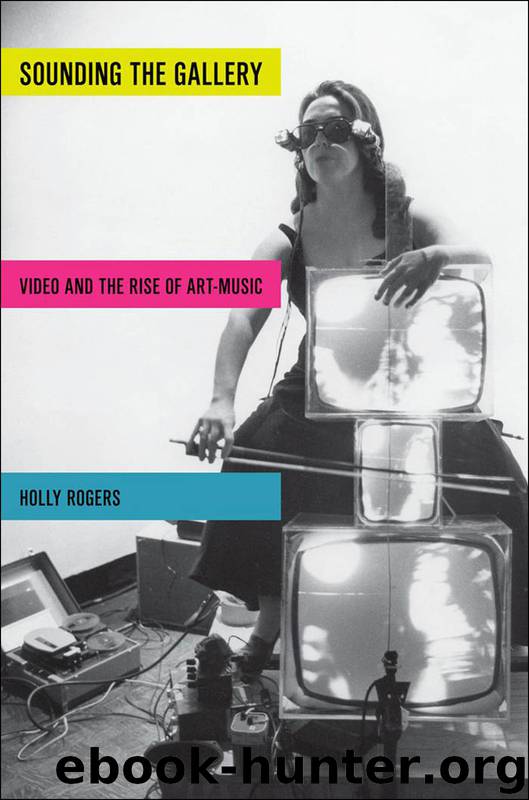Sounding the Gallery by Holly Rogers

Author:Holly Rogers
Language: eng
Format: epub
Publisher: Oxford University Press
Published: 2013-09-19T16:00:00+00:00
The Audiovisual Space
These multimedia spaces were of great importance to the audiovisual arenas of early video. But just as the audiovisuality of video can be traced back through centuries of creative practice, the increasing spatialisation of music and art that preceded the technology’s “integrating birth” (Spielmann) was a long process. The expansion of creative spaces experienced a quickened pace during the twentieth century, in which, to recall Moholy-Nagy, “The principle means of creation is the space itself.” At the same time as art began to break viewers from conventional viewing habits, murmurs of discontent were voiced in music circles concerning the ritualistic nature of performance. In the same way as art began to break free from its frame, the performance situation became an important component of music. The “relation” between elements became increasingly important, a refocus that enabled context to become content. As music attempted to break its spatial bonds and art its temporal ones, it was not long before the two converged: no longer contained within a frame or by the stage, art and music began to come together in a newly formed, audience-based performative space.
As we shall see in the next chapter, this space became the hunting ground for audiovisual video artists, who surrounded their viewers with music and images that transcended both the immobility of gallery exhibition and the segregation of performer/listener in the concert hall. Video’s ability to resculpt the gallery space in real time links it to the spatial expansions of both music and art and the multimedia spaces of expanded cinema. If we decentre the discussion of video from object to the environment in which video pieces reside, it is possible to trace for it an assortment of ancestries that enhance its intermedial qualities. On closer inspection, then, it is possible to revoice the assertion in my introduction to suggest that video art-music represents the culmination of both intermedial and spatial experimentation. In fact, the two histories are inextricably intertwined and although they are here presented in separate chapters, it must be remembered that neither expansion would have been as groundbreaking without the other. The material expansions of art and music outlined in the previous chapter can therefore be framed in terms of a parallel spatial expansion in both disciplines.
Download
This site does not store any files on its server. We only index and link to content provided by other sites. Please contact the content providers to delete copyright contents if any and email us, we'll remove relevant links or contents immediately.
The Kite Runner by Khaled Hosseini(5087)
Gerald's Game by Stephen King(4584)
Dialogue by Robert McKee(4326)
The Perils of Being Moderately Famous by Soha Ali Khan(4171)
The 101 Dalmatians by Dodie Smith(3454)
Story: Substance, Structure, Style and the Principles of Screenwriting by Robert McKee(3399)
The Pixar Touch by David A. Price(3369)
Confessions of a Video Vixen by Karrine Steffans(3247)
How Music Works by David Byrne(3191)
Fantastic Beasts: The Crimes of Grindelwald by J. K. Rowling(2996)
Harry Potter 4 - Harry Potter and The Goblet of Fire by J.K.Rowling(2993)
Slugfest by Reed Tucker(2945)
The Mental Game of Writing: How to Overcome Obstacles, Stay Creative and Productive, and Free Your Mind for Success by James Scott Bell(2847)
4 - Harry Potter and the Goblet of Fire by J.K. Rowling(2657)
Screenplay: The Foundations of Screenwriting by Syd Field(2576)
The Complete H. P. Lovecraft Reader by H.P. Lovecraft(2514)
Scandals of Classic Hollywood: Sex, Deviance, and Drama from the Golden Age of American Cinema by Anne Helen Petersen(2467)
Wildflower by Drew Barrymore(2445)
Robin by Dave Itzkoff(2387)
